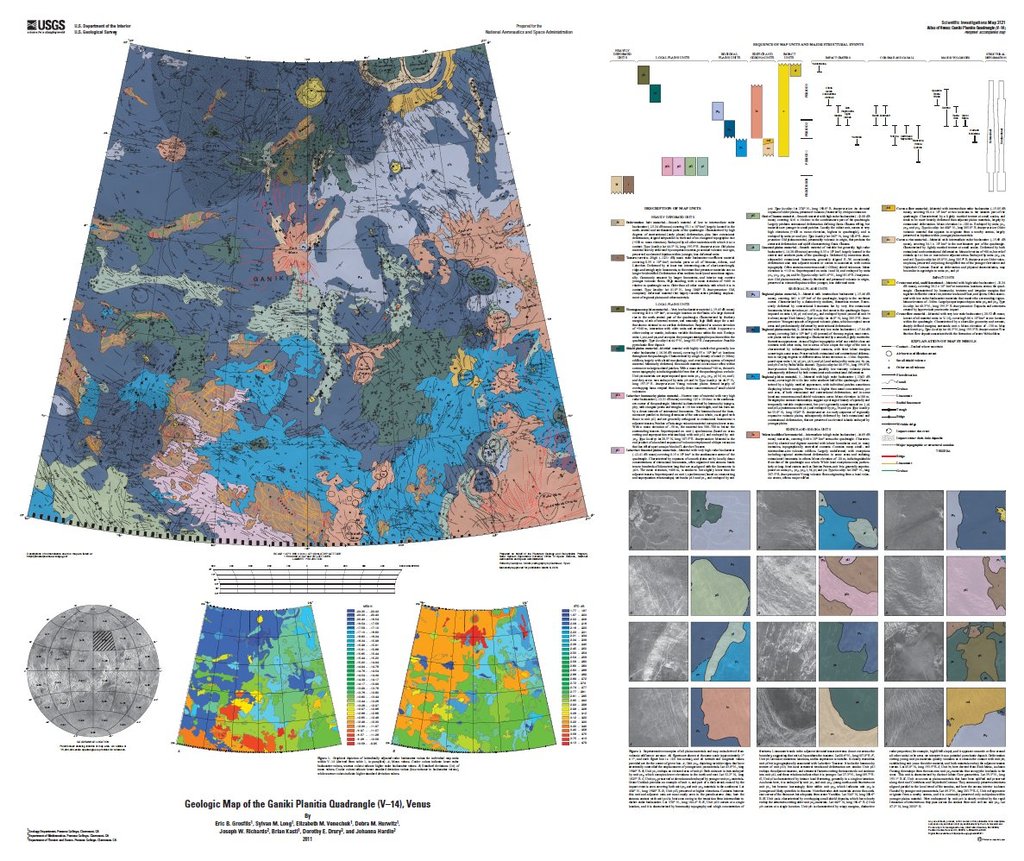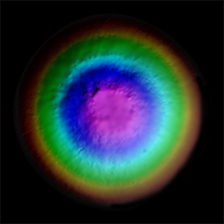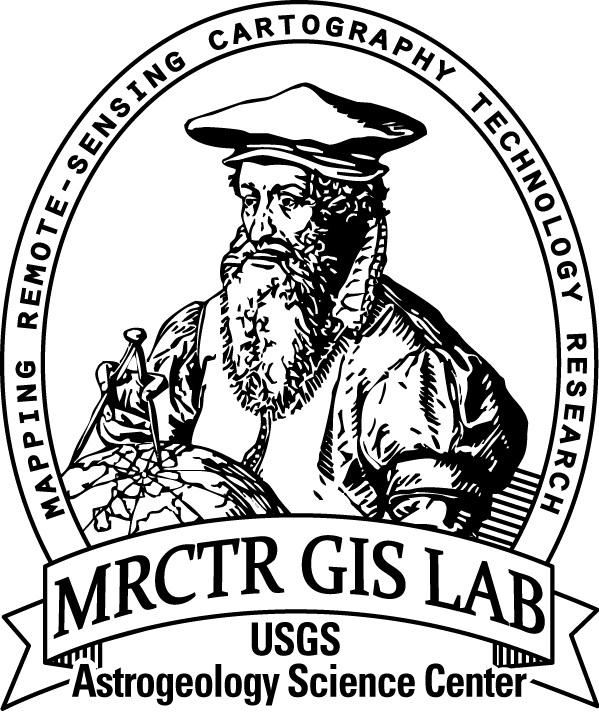Venus Geologic Map of the Ganiki Planitia Quadrangle
- Originators
- E Grosfils, S. Long, E. Venechuk, D. Hurwitz, J. Richards, B. Kastl, D. Drury, J. Hardin
- Publisher
- USGS Astrogeology Science Center
- Publication Date
- 2011-02-11
- Abstract
- The Ganiki Planitia (V-14) quadrangle on Venus, which extends from 25° N. to 50° N. and from 180° E. to 210° E., derives its name from the extensive suite of plains that dominates the geology of the northern part of the region. With a surface area of nearly 6.5 x 106 km2 (roughly two-thirds that of the United States), the quadrangle is located northwest of the Beta-Atla-Themis volcanic zone and southeast of the Atalanta Planitia lowlands, areas proposed to be the result of large scale mantle upwelling and downwelling, respectively. The region immediately south of Ganiki Planitia is dominated by Atla Regio, a major volcanic rise beneath which localized upwelling appears to be ongoing, whereas the area just to the north is dominated by the orderly system of north-trending deformation belts that characterize Vinmara Planitia. The Ganiki Planitia quadrangle thus lies at the intersection between several physiographic regions where extensive mantle flow-induced tectonic and volcanic processes are thought to have occurred. The geology of the V-14 quadrangle is characterized by a complex array of volcanic, tectonic, and impact-derived features. There are eleven impact craters with diameters from 4 to 64 km, as well as four diffuse 'splotch' features interpreted to be the product of near-surface bolide explosions. Tectonic activity has produced heavily deformed tesserae, belts of complex deformation and rifts as well as a distributed system of fractures and wrinkle ridges. Volcanic activity has produced extensive regional plains deposits, and in the northwest corner of the quadrangle these plains host the initial (or terminal) 700 km of the Baltis Vallis canali, an enigmatic volcanic feature with a net length of ~7,000 km that is the longest channel on Venus. Major volcanic centers in V-14 include eight large volcanoes and eight coronae; all but one of these sixteen features was noted during a previous global survey. The V-14 quadrangle contains an abundance of minor volcanic features including individual shield volcanoes and localized fissure eruptions as well as many small annular structures and domes, which often serve as the source for local lava flows. The topographic and geophysical characteristics of the Ganiki Planitia quadrangle are less complex than the surface geology, but they yield equally valuable information about the regionâs formation and evolution. Referenced to the mean planetary radius of 6051.84 km, the average elevation in the quadrangle is -0.26ñ0.86 km (2Ã) with a full range of -2.58 km to 1.85 km. The highest 2.5 percent of elevations in the quadrangle (above 0.60 km) are associated primarily with the major tessera blocks and the peaks of a few volcanic edifices, whereas the lowest 2.5 percent (below -1.12 km) mostly occur within corona interiors and in the northwest corner of the quadrangle where the plains begin to merge into the Atalanta Planitia lowlands. At the ~4.6 km/pixel scale of the topography data, the mean point-to-point topographic slope is 0.63° and topographic slopes greater than 2° cover less than 5 percent of the region. Overall, the topography of the Ganiki Planitia quadrangle can be characterized as flat, low lying, and nearly devoid of abrupt topographic variation. Complementing this gentle topography, the geoid anomaly has a generally linear gradient that decreases north-northwest from a high of ~20 m at the southern edge of the quadrangle (the northern border of the Atla Regio anomaly) to a low of -30 to -40 m along the northern edge (Konopliv and others, 1999). The vertical component of the gravity anomaly varies from ~50 mGal to -40 mGal, and integrated analysis of the gravity and topography data indicates that dynamically supported regions and areas of thickened crust are both present within the quadrangle. Because the Ganiki Planitia quadrangle is a plains-dominated lowland area that lies between several major physiographic provinces (namely, Atla Regio, Atalanta Planitia, and Vinmara Planitia), a geologic map of the region may yield insight into a wide array of important problems in Venusian geology. The current mapping effort and analysis complements previous efforts to characterize aspects of the regionâs geology, for example stratigraphy near parabolic halo crater sites, volcanic plains emplacement, wrinkle ridges, volcanic feature distribution, volcano deformation, coronae characteristics, lithospheric flexure, and various features along a 30±7.58° N. geotraverse. Our current research focuses on addressing four specific questions. Has the dominant style of volcanic expression within the quadrangle varied in a systematic fashion over time? Does the tectonic deformation within the quadrangle record significant regional patterns that vary spatially or temporally, and if so what are the scales, orientations and sources of the stress fields driving this deformation? If mantle upwelling and downwelling have played a significant role in the formation of Atla Regio and Atalanta Planitia as has been proposed, does the geology of Ganiki Planitia record evidence of northwest-directed lateral mantle flow connecting the two sites? Finally, can integration of the tectonic and volcanic histories preserved within the quadrangle help constrain competing resurfacing models for Venus?
Contact and Distribution
- Format
- Geologic Map, Raster Data, Vector Data
- Access Scope
- RPIF
- Series Id
- 3121
- Native Data Set Environment
- Astrogeology Theme
- Cartography, Geology, Geomorphology, Photogeology, Planetary evolution, Stratigraphy
- Online Package Link
- https://astrogeology.usgs.gov/search/map/venus_geologic_map_of_the_ganiki_planitia_quadrangle
- External File Size
- 278601828
- Online File Link
- http://astropedia.astrogeology.usgs.gov/download/Venus/Geology/year-2010/Venus-Geologic-Map-of-the-Ganiki-Planitia-Quadrangle-V-14.zip
- Access Instructions
- Map: 43.86 inches x 36.87 inches; Pamphlet: ii, 30 p.
- Contact Address
- 2255 N. Gemini Drive
- Contact City
- Flagstaff
- Contact State
- AZ
- Contact Postal Code
- 86001
- Contact Email
- astroweb@usgs.gov
Geospatial Information
- Target
- Venus
- Well Known Text (WKT)
- POLYGON((150 50, 180 50, 180 25, 150 25, 150 50))
- Minimum Latitude
- 25
- Maximum Latitude
- 50
- Minimum Longitude
- 150
- Maximum Longitude
- 180
- Object Type
- Grid Cell
- Quad Name
- V-13
- Map Scale (hard-copy)
- 1:5000000
- Horizontal Coordinate System Units
- Degrees



















